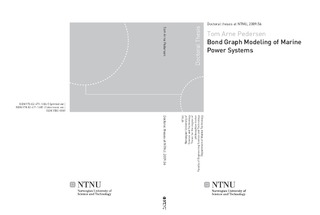| dc.contributor.author | Pedersen, Tom Arne | nb_NO |
| dc.date.accessioned | 2014-12-19T12:05:21Z | |
| dc.date.available | 2014-12-19T12:05:21Z | |
| dc.date.created | 2009-05-25 | nb_NO |
| dc.date.issued | 2009 | nb_NO |
| dc.identifier | 218922 | nb_NO |
| dc.identifier.isbn | 978-82-471-1486-5 (printed ver.) | nb_NO |
| dc.identifier.isbn | 978-82-471-1487-2 (electronic ver.) | nb_NO |
| dc.identifier.uri | http://hdl.handle.net/11250/237668 | |
| dc.description.abstract | Mathematical models for an All Electric Ship component library is developed in this thesis.
The main motivation for writing this thesis is to develop a model library that gives the opportunity to simulate both existing and new machinery systems without having to remodel the entire system each time. The model library should support the process of modeling and reuse, and also emphasize openness to brace the modeler during the development and refinement phase.
The bond graph approach is good when it comes to physical modeling of systems, it is a good tool for combining different energy domains and it may help understanding the system. In addition, bond graph is a powerful method to find dependencies between different components. By using causal analysis any problems in the model, e.g. algebraic constrains or dependent system variables will be detected, and necessary remodeling may be performed to handle such problems. The bond graph approach is therefore used when developing the component library.
The component library consists of selected power producers like diesel and gas engines, fuel cell and synchronous generator, and power consumers like asynchronous motor with voltage source converter and generic load used for hotel and auxiliary loads. The library also consist of a ship model, propeller and environmental loads. Most of the components have been verified using test measurements from manufacturer and full scale measurements from a supply vessel operating in the North Sea.
The main contributions of the thesis are:
• Development of a flexible component library used for modeling and simulation of existing and new marine power plants.
• Component models are verified using test measurements performed by manufacturer and full-scale measurements from a supply-vessel.
• Simulation of selected cases of combined power plants during extreme dynamic loads are conducted.
• Development of a hybrid causality generator model for increased flexibility when simulating combined power plants.
The library components are developed using 20Sim. 20Sim is also used for time domain simulation of the power plant test cases. | nb_NO |
| dc.language | eng | nb_NO |
| dc.publisher | Norges teknisk-naturvitenskapelige universitet, Fakultet for ingeniørvitenskap og teknologi, Institutt for marin teknikk | nb_NO |
| dc.relation.ispartofseries | Doktoravhandlinger ved NTNU, 1503-8181; 2009:56 | nb_NO |
| dc.title | Bond Graph Modeling of Marine Power Systems | nb_NO |
| dc.type | Doctoral thesis | nb_NO |
| dc.contributor.department | Norges teknisk-naturvitenskapelige universitet, Fakultet for ingeniørvitenskap og teknologi, Institutt for marin teknikk | nb_NO |
| dc.description.degree | PhD i marin teknikk | nb_NO |
| dc.description.degree | PhD in Marine Technology | en_GB |
